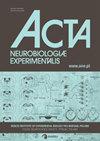Preventive effects of crocin, a natural compound from saffron, against nicotine‑induced oxidative stress and neurobehavioral disturbances
IF 1.4
4区 医学
Q4 NEUROSCIENCES
引用次数: 0
Abstract
Nicotine is a psychostimulant that induces neurochemical and behavioral changes upon chronic administration, leading to neurodegenerative conditions associated with smoking. As of now, no preventive or therapeutic strategies are known to counteract nicotine‑induced neurodegeneration. In this study, we explore the neuroprotective effects of crocin, a bioactive agent commonly found in saffron – a spice derived from the flower of Crocus sativus – using a rat model. The dose‑dependent effects of crocin were evaluated in nicotine‑induced neurodegeneration and compared with a control group. Neurobehavioral changes, assessed through the elevated plus maze, the open field test, the forced swim test, and the Morris water maze, as well as oxidative stress in the hippocampus, were evaluated. Interestingly, nicotine administration resulted in depression, anxiety, and abnormal motor and cognitive functions, while crocin treatment protected the rat brain from these abnormalities. The beneficial effects of crocin were associated with reduced oxidative stress biomarkers such as malondialdehyde, along with increases in superoxide dismutase, glutathione peroxidase, and glutathione reductase activities. These results demonstrate that crocin can mitigate nicotine‑induced neurodegeneration by reducing oxidative stress, potentially offering a protective measure against neurodegenerative effects in smokers.藏红花中的天然化合物黄花苷对尼古丁诱导的氧化应激和神经行为紊乱的预防作用
尼古丁是一种精神兴奋剂,长期服用会诱发神经化学和行为变化,导致与吸烟相关的神经退行性病变。到目前为止,还没有已知的预防或治疗策略来对抗尼古丁诱导的神经退行性病变。在本研究中,我们以大鼠为模型,探讨了藏红花中常见的生物活性物质藏红花素对神经的保护作用。在尼古丁诱导的神经变性中评估了巴豆苷的剂量依赖性效应,并与对照组进行了比较。通过高架加迷宫、开阔地试验、强迫游泳试验和莫里斯水迷宫评估了神经行为的变化,并评估了海马的氧化应激。有趣的是,服用尼古丁会导致大鼠抑郁、焦虑、运动和认知功能异常,而服用巴豆素则能保护大鼠大脑免受这些异常现象的影响。巴豆素的有益作用与氧化应激生物标志物(如丙二醛)的减少以及超氧化物歧化酶、谷胱甘肽过氧化物酶和谷胱甘肽还原酶活性的增加有关。这些结果表明,巴豆苷可以通过减少氧化应激来减轻尼古丁诱导的神经退行性变,从而为吸烟者提供一种防止神经退行性变的保护措施。
本文章由计算机程序翻译,如有差异,请以英文原文为准。
求助全文
约1分钟内获得全文
求助全文
来源期刊
CiteScore
2.20
自引率
7.10%
发文量
40
审稿时长
>12 weeks
期刊介绍:
Acta Neurobiologiae Experimentalis (ISSN: 0065-1400 (print), eISSN: 1689-0035) covers all aspects of neuroscience, from molecular and cellular neurobiology of the nervous system, through cellular and systems electrophysiology, brain imaging, functional and comparative neuroanatomy, development and evolution of the nervous system, behavior and neuropsychology to brain aging and pathology, including neuroinformatics and modeling.

 求助内容:
求助内容: 应助结果提醒方式:
应助结果提醒方式:


